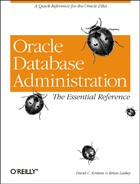- Dedication
- Preface
- I. DBA Tasks
- 1. Introduction
- 2. Installation
- 3. Maximizing Oracle Performance
- 4. Preventing Data Loss
- 5. Oracle Networking
- Oracle Names
- MultiProtocol Interchange
- Connecting to Non-Oracle Databases
- Network Manager Data Storage
- Using Network Manager
- Files Created by Network Manager
- Oracle Net8 Assistant
- Manual Network Configuration
- Sample SQL*Net Files
- SQL*Net Troubleshooting
- 6. Security and Monitoring
- 7. Auditing
- 8. Query Optimization
- 9. Oracle Tools
- 10. The Oracle Instance
- 11. The Oracle Database
- 12. Initialization Parameters
- 13. SQL Statements for the DBA
- SQL Commands by Task
- SQL Command Syntax
- Reference Section
- Reference Section
- Reference Section
- Reference Section
- Reference Section
- Reference Section
- Reference Section
- Reference Section
- Reference Section
- Reference Section
- Reference Section
- Reference Section
- Reference Section
- Reference Section
- Reference Section
- Reference Section
- Reference Section
- Reference Section
- Reference Section
- Reference Section
- column_constraint_clause
- auto_extend_clause
- for_clause
- filespec
- autoextend_clause
- global_index_clause
- local_index_clause
- table_constraint_clause
- table_ref_clause
- column_ref_clause
- column_constraint_clause
- index_organization_clause
- segment_attrib_clause
- partition_clause
- autoextend_clause
- 14. The Oracle Data Dictionary
- Static Data Dictionary Views
- Dynamic Performance Data Dictionary Views
- 15. System Privileges and Initial Roles
- 16. Tools and Utilities
Redo Logs
Redo logs, also called online redo log files, are critical to Oracle’s ability to recover from a failure. Proper configuration of redo logs is critical not only to overall database performance, but also to your ability to recover the database (see Chapter 4). Guidelines include the following:
Use Oracle’s built-in mirroring capability and put multiple sets of redo log files on different disk devices.
Allocate enough redo log files so that Oracle does not have to wait for a file to complete archiving before it is reused. Oracle requires at least two redo log files, but four or more may be necessary.
Allocate redo log files that are large enough to prevent too many log switches, but small enough to support good recovery if the current online log file is lost in a failure. With smaller files, you will probably be able to recover all transactions that have been archived, whereas a large log file size exposes the database to the potential for more lost transactions.
Set the INIT.ORA parameter LOG_CHECKPOINT_INTERVAL to a value larger than the size of your redo log files. This will prevent checkpoints until the log file is full (which forces a checkpoint). This parameter is expressed in database blocks.
Warning
Remember that a log switch causes dirty (i.e., updated) buffers to be written to disk from the SGA.
If you are running Oracle7, consider setting the INIT.ORA parameter CHECKPOINT_PROCESS to TRUE. Doing so creates a separate process that performs the checkpoint, rather than the LGWR (Log Writer) process. See Chapter 10, for more information.
-
No Comment
